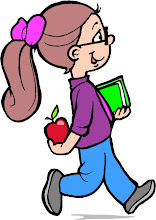We switched to the reader,
Pilgrim Boy. It is a third grade A Beka reading book that I picked up at the thrift store. I decided to use it now since it goes with the time period we are studying in history. It has comprehension questions after each chapter. There are 16 short chapters.
We finished
Pilgrim Boy and started reading BJU's 3-1 reading book again.
Comprehension Skills
This section is learning to read at different speeds. You read rapidly when skimming to find an answer or searching for a name in the phone book (yeah, who does that anymore!). You read carefully when studying, following directions, etc. A normal rate is used when reading for enjoyment.
- Obey the Speed Limit; this was a board game in the book, players took a card, read it and followed the directions. Cards said things like:
- Whoops! That is too fast to read directions for putting a model together. Move back 2 spaces.
- The directions to the game you want to play are complicated. Move ahead 1 space very slowly.
- Good for you! You found the key word in the paragraph. Move ahead 3 spaces.
- This joke is pretty good. Move ahead 2 spaces and read at a normal rate to enjoy it.
- Where are the Phrases?; one way to read rapidly is to read in phrases rather than word by word. We looked at a poem and broke it into phrases.
- I had K. read a science experiment rapidly. Then asked her what we were supposed to do. Then I had her read it slowly and asked her again.
- We searched for friends names in the telephone book.
- I read a story to her and we found the five most important words in some of the paragraphs.
From
Games for Reading:
- See It - Name It page 138 -- we did this on the way to the park one day
- Goofy Sentences page 64
- Interview with an Alligator page 171
- Go Togethers page 140










